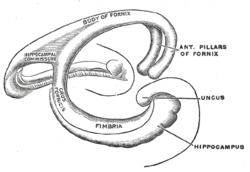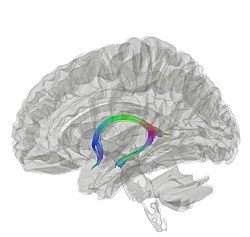利用者:加藤勝憲/脳弓
| 脳: Fornix | |
|---|---|
|
Diagram of the fornix. Right=anterior Tractography showing fornix | |
| 名称 | |
| 日本語 | Fornix |
| ラテン語 | Fornix |
| 動脈 | Small medial central branches of the anterior communicating artery |
| 関連情報 | |
フォルニクス(fornix、ラテン語: fornix)は、海馬の主要な出力路として働く脳内の神経線維のC字型の束である。また、脳弓はまた、間脳と前脳基底部の構造から海馬への求心性線維も運んでいる。脳弓は大脳辺縁系の一部である。脳の生理学におけるフォルニクスの正確な機能と重要性はまだ完全には解明されていないが、フォルニクスの外科的切断(フォルニクスの体に沿って切断すること)が記憶喪失を引き起こすことがヒトで証明されている。この損傷によってどのような種類の記憶が影響を受けるかについては議論があるが、認識記憶よりもむしろ想起記憶と最も密接な相関があることがわかっている。つまり、前庭の損傷は、過去の出来事の詳細など長期的な情報の想起を困難にするが、物体や見慣れた状況を認識する能力にはほとんど影響を与えないということである。
The fornix (from ラテン語: fornix) is a C-shaped bundle of nerve fibers in the brain that acts as the major output tract
recall memory rather than recognition memory.
Structure
[編集]

線維は脳の両側の海馬で辺縁として始まり、左右に分かれた辺縁はそれぞれフォルニクスの頭蓋(複数形crura)と呼ばれる。線維の束は脳の正中線で集まり、フォルニクス本体を形成する。脳室中隔(側脳室を隔てる膜)の下縁は、前庭体の上面に付着している。
The fibers begin in the hippocampus on each side of the brain as fimbriae; the separate left and right sides are each called the crus of the fornix (plural crura). The bundles of fibers come together in the midline of the brain, forming the body of the fornix. The lower edge of the septum pellucidum (the membrane that separates the lateral ventricles) is attached to the upper face of the fornix body.
前庭の本体は前方に移動し、前交連付近で再び分かれる。左右に分かれるが、前後分岐もある。
anterior commissure.
- The posterior fibers (called the postcommissural fornix) of each side continue through the hypothalamus to the mammillary bodies; then to the anterior nuclei of thalamus.
- The anterior fibers (precommissural fornix) end at the septal nuclei of the basal forebrain and nucleus accumbens of each half of the brain.
Commissure
[編集]前庭の体側部は、プサルテリウム(リラ)と名付けられた薄い三角形の薄板で結合されている。この薄板には、2つの海馬を中間線で結ぶ交連線維があり、海馬交連を構成している(海馬交連とも呼ばれる)。
some commissural fibers that connect the two hippocampi across the middle line and constitute the commissure of fornix (also called the hippocampal commissure).
末端薄板は交連板を形成する。この構造により、脳梁、中隔、前庭が形成される。フォルニクスは前方で2本の柱に分かれ(前柱)、その後2つの後十字に分かれる。この2つの柱は海馬交連を介して結合する。分裂の始まりは、プサルテリウム(psalterium)またはリラ・ダヴィディス(Lyra Davidis)と呼ばれる。後者の名称は、その構造がライラ(または三角琴)に似ていることから用いられている:2つのクルーラはリラの「シャーシ」であり、交連は線維である。
Columns
[編集]The columns (anterior pillars; fornicolumns) of the fornix arch downward in front of the interventricular foramina and behind the anterior commissure, and each descends through the grey matter in the lateral wall of the third ventricle to the base of the brain, where it ends in the mammillary bodies.
Crus
[編集]フォルニクスのクルーラ(後柱)は胴体から後方に伸びている。
これは扁平な帯状で、その始点は脳梁の下面と密接につながっている。
互いに分岐し、それぞれが視床の後端を回ってカーブし、側脳室の側頭角へと下方から前方へと通過する。
Here, it lies along the concavity of the hippocampus, on the surface of which some of its fibers are spread out to form the alveus, while the remainder is continued as a narrow white band, the fimbria of hippocampus, which is prolonged into the uncus of the parahippocampal gyrus.
Functional consequences of fornix damage
[編集]The fornix is essential for acquiring and consolidating new episodic memories. Fornix transection studies in macaques[1] have shown that the monkeys were strongly impaired on object-in-scene learning, which is a type of recall memory, specifically episodic-like memory (integrating what and where, although not when). Fornix transection in rodents impairs performance on tasks that require the encoding and retrieval of spatiotemporal context and, therefore, serves as a proxy for human episodic memory. For instance, fornix transection consistently leads to robust impairments in learning new routes and spatial locations.[2]
Fornix damage in humans is rare; a few individuals have had their fornix transected inadvertently during removal of colloid cysts from their third ventricles.[3] Nevertheless this small literature has consistently reported a persistent anterograde amnesia that is indistinguishable from the anterograde amnesia observed after focal hippocampal lesions. Deficits in recall are greater than for recognition, and the deficit is found across all types of material (e.g. visual and verbal).[2] This supports the idea that damage to any part of the extended hippocampal memory system causes similar memory deficits.[4] Other aspects of cognition, such as social cognition and language ability, remain intact after fornix damage.
Lesion findings have been extended by work using the non-invasive in vivo technique diffusion-weighted imaging. This literature has shown that fractional anisotropy (FA) in the fornix decreases with advanced age, correlates with age-related memory impairments, and is relatively decreased in mild cognitive impairment and in Alzheimer's disease.[5][2] New research studies are using deep brain stimulation to stimulate the fornix as some evidence has shown that doing so improves episodic memory.[6]
Function
[編集]The fornix is the conduit by which the neurotransmitter acetylcholine – which is crucial for memory encoding – is sent from the medial septum/Diagonal band of Broca to the hippocampus.[7] In addition, the GABA-producing neurons in the septal nuclei generate theta rhythms which are transmitted through the fornix to the hippocampus.[8][9] In the absence of these external modulators, the hippocampus is radically dysfunctional. In addition, the fornix transmits mnemonic information from the hippocampus to deep brain structures, which potentially allows us to use stored memories to guide us to rewarding people, places, and sources of sustenance.
Additional images
[編集]Template:Commissural fibers and septum
出典
[編集]この記事にはパブリックドメインであるグレイ解剖学第20版(1918年)本文が含まれています。
- ^ Gaffan, D. (1994). “Scene-specific memory for objects: a model of episodic memory impairment in monkeys with fornix transection”. Journal of Cognitive Neuroscience 6 (4): 305–320. doi:10.1162/jocn.1994.6.4.305. ISSN 0898-929X. PMID 23961727.
- ^ a b c Reviewed by Benear, Susan; Ngo, Chi; Olson, Ingrid R. (2019). “Dissecting the fornix in basic memory processes and neuropsychiatric disease: A review”. Brain Connectivity 10 (7): 331–354. doi:10.31234/osf.io/bnfmu. PMC 7495920. PMID 32567331.
- ^ Aggleton, J. P.; McMackin, D.; Carpenter, K.; Hornak, J.; Kapur, N.; Halpin, S.; Wiles, C. M.; Kamel, H. et al. (2000-04-01). “Differential cognitive effects of colloid cysts in the third ventricle that spare or compromise the fornix” (英語). Brain 123 (4): 800–815. doi:10.1093/brain/123.4.800. ISSN 0006-8950. PMID 10734011.
- ^ Aggleton, J. P.; Brown, M. W. (1999). “Episodic memory, amnesia, and the hippocampal–anterior thalamic axis.”. Behavioral and Brain Sciences 22 (3): 425–489. doi:10.1017/S0140525X99002034. PMID 11301518.
- ^ Reviewed by Douet, V; Chang, L (2015). “Fornix as an imaging marker for episodic memory deficits in healthy aging and in various neurological disorders”. Frontiers in Aging Neuroscience 6: 343. doi:10.3389/fnagi.2014.00343. PMC 4294158. PMID 25642186.
- ^ Reviewed by Senova, S; Fomenko, A.; Gondard, E.; Lozano, A. M. (2020). “Anatomy and function of the fornix in the context of its potential as a therapeutic target”. Journal of Neurology, Neurosurgery & Psychiatry 91 (5): 547–559. doi:10.1136/jnnp-2019-322375. PMC 7231447. PMID 32132227.
- ^ Reviewed in Hasselmo, M. E. (1999). “Neuromodulation: acetylcholine and memory consolidation”. Trends in Cognitive Sciences 101 (9): 351–359. doi:10.1016/S1364-6613(99)01365-0. PMID 10461198.
- ^ Cassel, J. C. (1997). “The fimbria-fornix/cingular bundle pathways: A review of neurochemical and behavioral approaches using lesions and transplantation techniques.”. Progress in Neurobiology 51 (6): 663–716. doi:10.1016/S0301-0082(97)00009-9. PMID 9175161.
- ^ Rawlins, J. N. P.; Feldon, J.; Gray, J. A. (1979). “Septo-hippocampal connections and the hippocampal theta rhythm”. Experimental Brain Research 37 (1): 49–63. doi:10.1007/BF01474253. PMID 385334.
外部リンク
[編集]- More info at BrainInfo
Template:Commissural fibers and septumTemplate:Commissural fibers and septum [[Category:大脳辺縁系]] [[Category:大脳]] [[Category:未査読の翻訳があるページ]]






